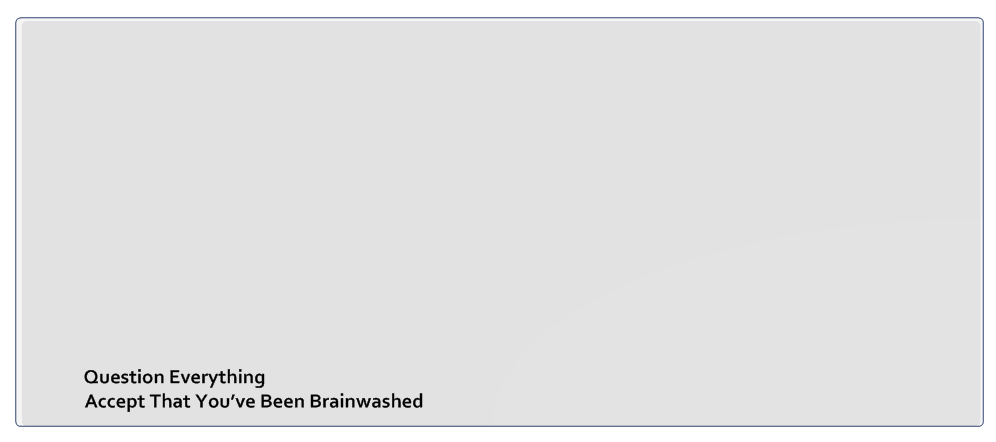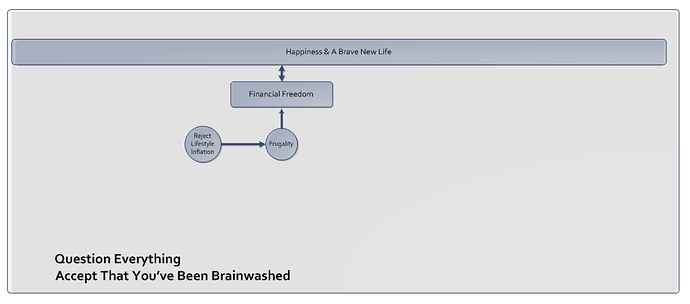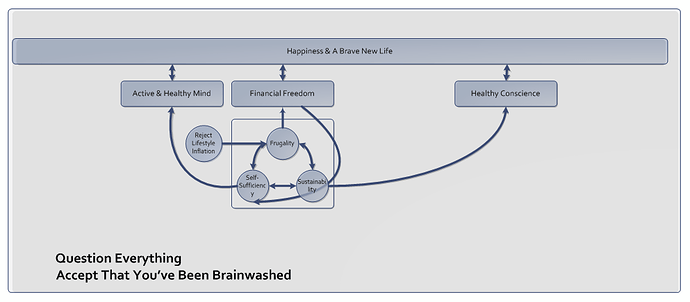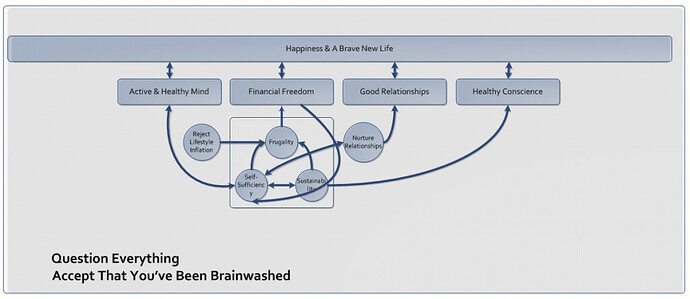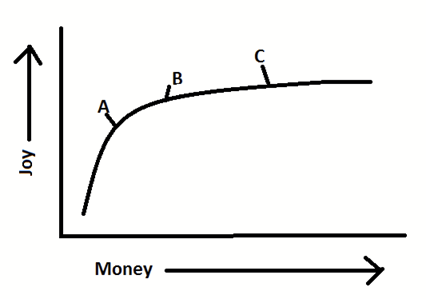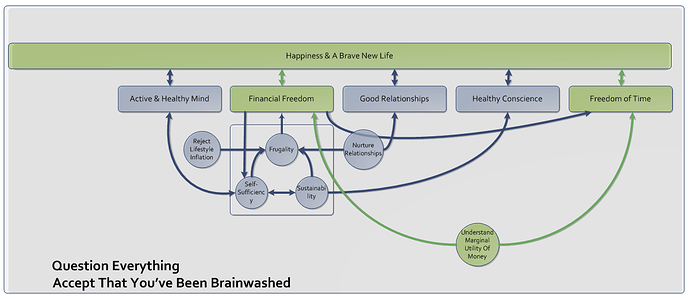Core Principle #3: Frugality, Self-Sufficiency, and Sustainability
[Archived copy of this original post]
There is a deep and important correlation between frugality, self-sufficiency, and sustainability. Recognizing this relationship is critical to the brave new life philosophy. There are hundreds of books and blogs on each, but rarely do you see the three tied together. The inter-relation between them is why I chose to make them a single core principle.
It’s very important to tie them together. Bind them in unison, let one support the other and become a philosophy. Some life decisions are hard when you only consider one, but become very easy and obvious when all 3 support the same decision. And it’s quite often that all 3 do support a single decision.
Part 1 – Frugality
Frugality, for most people, is a means to an end. For some (those not seeking a brave new life) it’s a way to save money on stuff so you can just spend it somewhere else.
Hey, if I cut coupons and stop drinking that daily $4 vanilla mocha latte with soy milk I can save up for a Carribean cruise (because I deserve it!).
This is not the frugality I’m talking about.
For the BNL type, frugality is a means to an end to achieve financial freedom. Financial freedom buys you freedom from doing things you would rather not, like sitting in a cubicle on a beautiful sunny day. A financially free person can make personal decisions that make them happy and satisfied.
Part 2 – Self Sufficiency
Self-sufficiency is the state of not requiring outside help in order to survive. But by “self-sufficiency,” I don’t mean that you need to move out to Walden pond, chop wood, and eat only what you hunt or gather. (Although this does sound like a nice week-long getaway). Instead, the self-sufficiency I’m proposing is a group state that consists of your family, friends, and local community.
There are two ways to increase your self-sufficiciency:
1. Increase knowledge across each area of your life
Increasing knowledge can be accomplished by using books, the internet, friends’ knowledge, and experimentation. Since making the decision to become more self-sufficient, I’ve used all 4 of these in the past year. I read books about private money lending, and attend a free seminars in order to learn to make money independent of a job. I had a neighbor teach me how to tune-up my bike, which I had never done before. I used an website to learn how to diagnose my broken furnace, and a youtube video to figure out how to replace my busted furnace ignitor. All of these things have led to an increased knowledge base and further self-sufficiency. This increased knowledge is addictive, it becomes fun to do things yourself. In each of the examples I just gave, I also saved quite a bit of money – connecting us back to frugality.
Now let’s explore this form of self-sufficiency with a hypothetical example. It’s below freezing outside, snowing, and your furnace breaks. (This isn’t that hypothetical, it happened to me 2 months ago). You could call an expert to come in, but the fees will be $200, they can’t come until Monday (it’s Saturday), and the temperature in your house is dropping 3 degrees per hour. So you have to book a hotel for 2 days, pack up the kids, and leave. Total cost is $400, two sleepless nights in a cramped hotel room with 2 kids, and no knowledge gained.
Alternatively, you could get on the internet and start diagnosing the problem. You figure out that your furnace doesn’t have a pilot light, instead it uses a silicon carbide ignitor – and you see that it’s not igniting. According to the vast knowledge of the internet, this means it’s either not getting the voltage input it needs, or it’s gone bad. So you get out your voltmeter and measure the voltage, which looks fine. You get back on the internet, learn that your particular ignitor costs just $25 at a local HVAC store, and can be replaced in minutes. Total cost: $25, 2 hours of labor/research, 2 good nights of sleep, new knowledge about how your furnace works, and a little bit of self-sufficiency pride.
2. Decrease complexity and quantity of what you need and want
The second method to increase self-sufficiency is to decrease the complexity and quantity of what you need and own. For example, why have a toaster that will eventually break when instead you could use the broiler in your oven? The toaster is just one more thing that can break. Why have a complex and loud toy for your kids when they are equally as happy with play dough, crayons, and some paper? Why have 2 cars when you can have 1 car and a bicycle? Once again, in each of the examples above you not only increase self-sufficiency, but you also increase frugality.
Let’s again explore a hypothetical example. Let’s say you own a Ferrari and your Ferrari breaks down. This is a complex vehicle with a lot of foreign parts that have to be ordered by a high-charging specialist. This is not self-sufficient.
Now let’s say you own a Ford Focus and your Focus brakes down. You may not know how to fix it, but you probably have a neighbor or buddy that can help get you started. That would be self-sufficient. Or perhaps you don’t have anyone that knows how, but there are 10 mechanics within 5 miles that can easily service the car. This is at least getting closer to self-sufficiency, and you did it by having a less complex product to achieve your transportation needs.
Now let’s say that you decide to move to a place closer to work, and buy a nice bike. But your bike brakes down, the chain pops. Even if you’ve never repaired or replaced a chain before, you are one YouTube video, 20 minutes of labor, and a $7 tool away from fixing it. This is self-sufficiency.
Once you start embracing self-sufficiency, you realize that simple, mechanical tools are preferred over complex ones. A bike is preferred over a car. A manual powered reel lawnmower is preferred over a self-propelled gas powered mower (which is still preferred over a riding tractor). A toaster is just one more thing that can break.
A final advantage of self-sufficiency is that it saves money, reducing your time to financial freedom and retirement, which then gives your even more time to be self-sufficient. It’s a wonderful positive feedback loop.
Part 3 – Sustainability
The Iroquois tribe had what they called the Great Law of the Iroquois, and it’s now referred to as Seven Generation Sustainability. Basically, it goes like this: “Do what you believe will benefit your children seven generations down the road.” This is how I define sustainability.
Example: Planting a tree is good, cutting one down to make a parking lot is bad. Patching a hole in your bike tire is good, buying a new one is bad.
Taking this philosophy is a huge burden, but an important one. The unsustainable lifestyles common in the industrialized world means that each unsustainable act you do, you are taking away from your children and grandchildren. When we run out of oil, when we pollute the water, when we use finite resources for our own pleasure, we are literally taking away from them.*
When we talk about frugality, we are referring to the reduction of spending. Sometimes this gets hard, even for me. Sometimes I want to drive to the store when I know I could walk or bike. Sometimes I want to buy a new laptop, when my current one works OK. Sometimes it’s simply not enough to be frugal to stay on track for an early retirement – and in those cases you need a commitment to sustainability to help you through.
When I think about driving to the store, I think about the Great Law of the Iroquois. And I think, will burning up more oil (something that will most likely be gone in 7 generations) be good or bad for my children, and their children, and so on? Or would it be better for me to save that limited energy for them, while also improving my health?
Will it be better for my childrens’ childrens’ children if I patch this bicycle tube, or should I pull more resources out of the ground to manufacture a new one?
It’s amazing how in-line frugality, self-sufficiency and sustainability are once you start putting these things together. This tight connection is why you see a few common themes on books and websites like mine (ERE, MMM, etc).
- Biking instead of driving
- Learning to cook healthy and simple foods from scratch (beans, rice, etc), rather than processed foods
- Fixing things instead of buying new things
All three of these examples are acts of frugality, self-sufficiency, and sustainability. (Note: they all happen to be healthier too, which is a common by-product).
The Blank Slate
Now your slate is filling out.
You’ll now notice that the pieces are starting to assemble, and that the support each other.
So far, we have three sources of happiness -
- An active/healthy mind
- Financial freedom,
- A Healthy conscience.
Financial freedom is directly and indirectly supported by the 4 contributing principles -
- the rejection of lifestyle inflation
- frugality
- self-sufficiency
- a sustainable lifestyle.
.
or a
.

